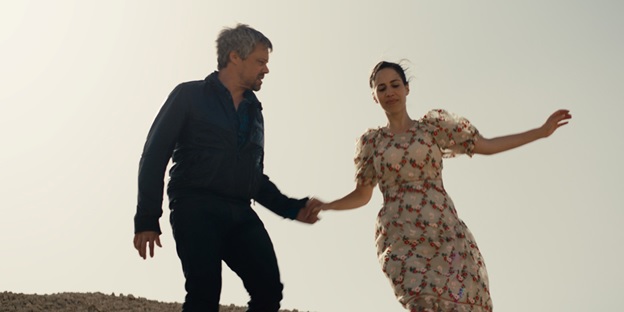Two of the best films that played at TIFF this year felt like self-conscious purgings of personal demons from the filmmakers. Formally, and aesthetically, the disjunctive abrasions of Nadav Lapid’s “Ahed’s Knee” seem a far cry from the period sensibilities of Terence Davies’ “Benediction”. But both films, at turns irreverent and provocative, feel like portraits of an artist as a stand-in for the director in intriguing and challenging ways.
Lapid’s “Ahed’s Knee” approaches this invocation of character as a thinly veiled version of director in a more direct way. Like much of Lapid’s work, whose previous film “Synonyms” (his best work) played at TIFF in 2019, “Ahed’s Knee” is explicitly about issues of Israeli identity, nationhood and personhood. This film, though, feels more personal than his previous entries. Like an angry cry that needs to be purged, or exorcised. Spurred by an incident in Israel, where a screening of a previous film was preceded by a request to sign a form censoring his remarks, “Ahed’s Knee” expands from that incident.
Y, a filmmaker very much like Lapid, is in the process of casting his latest film about a Palestinian activist who gains notoriety for slapping an Israeli officer. He arrives in Arava Valley to screen a previous film, hosted by Yahalom, the Deputy Director of Ministry of Culture’s library department. Y and Yahalom are intrigued by and sceptical of each other. Their contrasting ideals reach a climax when she asks him to sign a waiver to stick to government-sanctioned topics, and through this set-up, Lapid launches into his tirade on art, censorship, country and what feels like every other topic one can imagine.
It’s easy to see the thread from Lapid’s previous work to “Ahed’s Knee”, especially to “Synonyms,” as language serves to both disclose and equivocate. Avshalom Pollak is less arresting than Tom Mercier in “Synonyms”, but where Mercier’s ability to court sympathy was his gift, Pollak is arresting for the genuine unpredictability and danger that feels essential to his performance. It’s typically dissonant work from Lapid, who also writes the script. More than his screenplay, though, “Ahed’s Knee” is most dependent on the editing from Nili Feller, which conjures a feverish and disorienting atmosphere that feels two-steps ahead of the audience. It’s chaotic and slippery, and weird and uncompromising and Lapid refuses to make things easy for us. What’s most fascinating is how “Ahed’s Knee” insists on exploring tangents and peripheries, emphasising a world that feels sad and desolate but still with avenues worth exploring. The frenetic camerawork feels like a mirror for Y, who is always restless and rarely settled. Psychic chaos meets formal freneticism.

If Davies’ “Benediction” is similar, it is in that same penchant for exploring tangents. Where the camera in “Ahed’s Knee” feels agitated, the camera in “Benediction” moves slowly through halls and streets. Observing, and judging, all that it sees. Like Lapid, one can imagine this film as a referent to Davies’ previous work – particularly his most recent biopic of Emily Dickinson in “A Quiet Passion”.
Like that work, this is a biopic of a poet. “Benediction” considers the life of English poet Siegfried Sassoon, who gained fame as one of the most notable poets of the First World War. But, in typical Davies’ fashion, the film moves beyond the more familiar. After a brief section at war, “Benediction” explores Sassoon’s youthful malaise and fateful romances of his youth (played by Jack Lowden in these sections), and his ageing malaise and religiosity in his later years (played by Peter Capaldi).
“Benediction” is significant as the first of Davies’ films to explicitly exploring gay desire on screen. Davies, also gay, has explored queer themes to excellent effect in numerous subtextual ways, but the exploration in “Benediction” feels agitated and intentional, and personal. Like “Ahed’s Knee”, this feels like a purging. A hopeful, romantic who becomes jaded in his old age by his unwillingness to compromise, and the unreliability of the world around him. “Benediction” is preoccupied with too many things to name – ageing, religion, love, sex, artifice, art, war, masculinity, posterity. It is a treatise on existence, but it is also slippery about the things it considers, resisting readings. Alex Mackie’s editing moves between the timelines, Sassoon as a young man and Sassoon as an ageing man, in ways that feel like a horror movie at times. There’s a particular cut that felt so jarring for the way it forces the audience to consider what we might not want to. And it’s that kind of deliberately jarring, but thoughtful approach, that works so well in “Benediction”.
The middle section of the film, which sees Lowden’s Sassoon ambling through a string of less than worthy male lovers is deliberate in the way it challenges our ideas of presenting onscreen desire. Davies’ calling-card has always been a potent intentionality that always feels worked out. And reading “Benediction” through those lens feels instructive. In a rare move for a director who tends to prioritise fleshing out the smallest characters, “Benediction” resists the familiar and emphasises its artifice, presenting the clashes of male desires as built on performance, or sometimes the performance of a performance in ways that are disorienting and metatextual. That disorienting notion is most explicit in Jeremy Irvine as Ivor Novello, Sassoon’s most exhausting lover.
As played by Irvine, Novello feels like a grotesque celebrity version of male narcissism. It’s a mannered performance that, at times, seems to play up Irvine’s worse instincts. And yet, it’s also a performance that feels very worked out and functioning in specific ways within the text of the film that emphasise Davies’ ability to make aspects that feel jarring on their own make sense as a whole. It’s these kinds of ruptures that make “Benediction” feel even better days after seeing it, as if Davies’ work is a painting that needs time to settle in our brain. The more you consider its treatise on art and identity, the more it revels in its authenticity and sincerity. The very last moment reminds us of this, an aching shot of Lowden’s Sassoon looking out at us that goes on so long it begins to threaten discomfort. But we cannot look away, and the longer it continues the more it forces us to confront the cracks in illusions of self. In the moment Lowden is Sassoon but he also feels like Davies saying, take me as I am.
Both films close with moments of calm amidst the heightened passions that mark earlier moments. We return to our protagonist, alone, and contemplating the world around them. At the end, Lapid and Davies abandon the artifice for the real pain of the men at their centres, which is also their pain. In a year of varied approaches to identity at TIFF, these two films stick out for their formal experimentation, and for their clear approaches to art in the world.
I already want to see both of them again.






